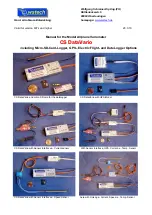
characteristics without often uncomfortable frequency steps. Model sailkplane pilots who are familiar with
varios in full scale planes confirm this. (By the way: CS stands for “classic sound”!)
Descent produces a continous tone which goes lower as the descent velocity is increasing. Climb (> 0 ft/sec
is default setting) produces an interrupted, rising tone. The pitch of the tone rises with increasing climb
velocity. As well, the interrupt cycle increases at the same time which might be expressed as “ beeeep,
beeep, beep, bep, bep...” (default setting)
The adjustment of the descent tone threshold can be setup individually. Before detailing this, some
definitions should be handy along the following simple graphics:
Two scales are compared, which for one show the vertical movement of the air mass and for the other show
the vertical velocity of the sailplane. Both scales are offset by the value Ve which is the intrinsic descent rate
of the sailplane model. On the average, Ve lies in the range of -1.5 ft/sec to -3 ft/sec. On the part of the
model, three areas and two thresholds are to be considered. The
climb threshold
indicates true altitude
gain of the sailplane. The
descent threshold
indicates sinking airmass. In between the sailplane is still
descending, yet the surrounding airmass is already climbing! This is called the “zero-lift area”.
Using the setup procedure the descent threshold can be adjusted between 0 ft/sec and – 6 ft/sec in steps of
0.3 ft/sec.
4.1
Voice output for vario and altimeter
In the vario- and altimeter function, the voice output can deliver either output:
•
Altitude
•
Integral vario/ sink rate
Switching between the outputs can be done from the transmitter during the flight by using an assigned 3-
position switch. Details are described in
chapter 6.
4.2
Optional Vario Acoustics Modes
As described above, airplane descent (descent rate > descent threshold) is signalled by a continous tone,
which goes lower as the descent increases. Airplane climb is signalled by a pulsed tone where the tone pitch
and the pulse rate increase with the climb rate.
The “zero lift area” is also signalled with a pulsed tone, yet this one differs from the proper climb tone
in that
it sounds a
50:50
duty cycle instead of a
25:75
duty cycle of the true lift. (duty cycle = sound on / sound off).
Thus, true lift, zero lift and true descent can easily be distinguished.
Setup7
and
Setup8
allow the adjustment of the descent threshold and the acoustics configuration.
Optionally it is possible to switch off the descent tone and the zero lift tone.
It is also possible to select a mode which neglects the separate signalling of the zero lift zone. This in turn
corresponds to the acoustics of the earlier ClassicSound varios.
The different mode setting options are described in
chapter 16
of this manual.
The various modes allow the adaption of the vario acoustics to the pilot`s preferences. Yet, the default
settings on delivery will insure a successful start-up for the vario novice.




















